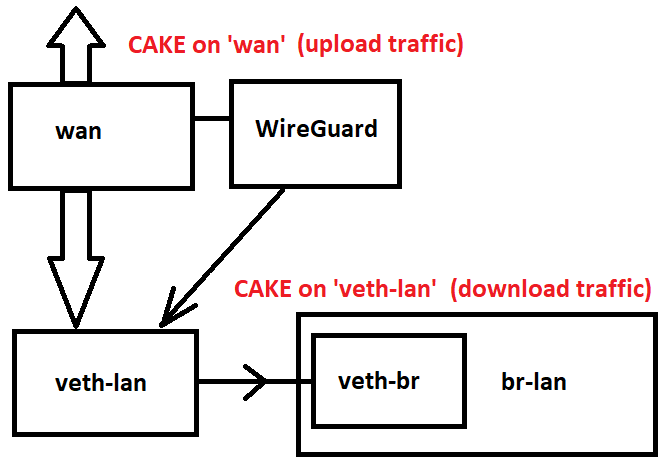I am using elan example config :
config defaults
list defaults /etc/qosify/*.conf
option dscp_icmp +besteffort
option dscp_default_tcp unmarked_traffic
option dscp_default_udp unmarked_traffic
config class unmarked_traffic
option ingress CS1
option egress CS1
option prio_max_avg_pkt_len 1270
option dscp_prio CS4
option bulk_trigger_pps 600
option bulk_trigger_timeout 10
option dscp_bulk CS1
config class browsing
option ingress CS0
option egress CS0
option prio_max_avg_pkt_len 575
option dscp_prio AF41
option bulk_trigger_pps 1000
option bulk_trigger_timeout 10
option dscp_bulk CS1
config class bulk
option ingress CS1
option egress CS1
config class besteffort
option ingress CS0
option egress CS0
config class network_services
option ingress CS2
option egress CS2
config class broadcast_video
option ingress CS3
option egress CS3
config class gaming
option ingress CS4
option egress CS4
config class multimedia_conferencing
option ingress AF42
option egress AF42
option prio_max_avg_pkt_len 575
option dscp_prio AF41
config class telephony
option ingress EF
option egress EF
config interface pppoe-wan
option name pppoe-wan
option disabled 0
option bandwidth_up 180mbit
option bandwidth_down 180mbit
option overhead_type docsis
# defaults:
option ingress 1
option egress 1
option mode diffserv4
option nat 1
option host_isolate 1
option autorate_ingress 0
option ingress_options ""
option egress_options "wash"
option options "ether-vlan"
config device wandev
option disabled 1
option name wan
option bandwidth 100mbit
My LAN is connecting to the Internet through a PPPOE client named "pppoe-wan"
Here is my ip -a :
root@host:/etc/init.d# ip a
1: lo: <LOOPBACK,UP,LOWER_UP> mtu 65536 qdisc noqueue state UNKNOWN group default qlen 1000
link/loopback 00:00:00:00:00:00 brd 00:00:00:00:00:00
inet 127.0.0.1/8 scope host lo
valid_lft forever preferred_lft forever
inet6 ::1/128 scope host
valid_lft forever preferred_lft forever
2: eth0: <BROADCAST,MULTICAST,UP,LOWER_UP> mtu 1500 qdisc mq master br-lan state UP group default qlen 1000
link/ether 40:62:31:0b:fc:5b brd ff:ff:ff:ff:ff:ff
3: eth1: <BROADCAST,MULTICAST,UP,LOWER_UP> mtu 1500 qdisc mq master br-lan state UP group default qlen 1000
link/ether 40:62:31:0b:fc:5c brd ff:ff:ff:ff:ff:ff
4: eth2: <BROADCAST,MULTICAST,UP,LOWER_UP> mtu 1500 qdisc mq master br-lan state UP group default qlen 1000
link/ether 40:62:31:0b:fc:5d brd ff:ff:ff:ff:ff:ff
5: eth3: <BROADCAST,MULTICAST,UP,LOWER_UP> mtu 1500 qdisc mq master br-lan state UP group default qlen 1000
link/ether 40:62:31:0b:fc:5e brd ff:ff:ff:ff:ff:ff
6: eth4: <BROADCAST,MULTICAST,UP,LOWER_UP> mtu 1500 qdisc mq master br-lan state UP group default qlen 1000
link/ether 40:62:31:0b:fc:5f brd ff:ff:ff:ff:ff:ff
7: eth5: <BROADCAST,MULTICAST,UP,LOWER_UP> mtu 1500 qdisc mq state UP group default qlen 1000
link/ether 40:62:31:0b:fc:60 brd ff:ff:ff:ff:ff:ff
8: ip6tnl0@NONE: <NOARP> mtu 1452 qdisc noop state DOWN group default qlen 1000
link/tunnel6 :: brd :: permaddr 7eb6:f125:7960::
9: sit0@NONE: <NOARP> mtu 1480 qdisc noop state DOWN group default qlen 1000
link/sit 0.0.0.0 brd 0.0.0.0
10: gre0@NONE: <NOARP> mtu 1476 qdisc noop state DOWN group default qlen 1000
link/gre 0.0.0.0 brd 0.0.0.0
11: gretap0@NONE: <BROADCAST,MULTICAST> mtu 1462 qdisc noop state DOWN group default qlen 1000
link/ether 00:00:00:00:00:00 brd ff:ff:ff:ff:ff:ff
12: erspan0@NONE: <BROADCAST,MULTICAST> mtu 1450 qdisc noop state DOWN group default qlen 1000
link/ether 00:00:00:00:00:00 brd ff:ff:ff:ff:ff:ff
13: ip6gre0@NONE: <NOARP> mtu 1448 qdisc noop state DOWN group default qlen 1000
link/gre6 :: brd :: permaddr 368b:66b6:96f0::
14: teql0: <NOARP> mtu 1500 qdisc noop state DOWN group default qlen 100
link/void
16: br-lan: <BROADCAST,MULTICAST,UP,LOWER_UP> mtu 1500 qdisc noqueue state UP group default qlen 1000
link/ether 40:62:31:0b:fc:5b brd ff:ff:ff:ff:ff:ff
inet 10.10.8.1/21 brd 10.10.15.255 scope global br-lan
valid_lft forever preferred_lft forever
17: pppoe-wan: <POINTOPOINT,MULTICAST,NOARP,UP,LOWER_UP> mtu 1492 qdisc fq_codel state UNKNOWN group default qlen 3
link/ppp
inet 123.123.123.123 peer 123.123.123.1/32 scope global pppoe-wan
valid_lft forever preferred_lft forever
inet6 123::123:123:123:123 peer 123::123:123:123:123/128 scope link
valid_lft forever preferred_lft forever
18: ifb-dns: <BROADCAST,NOARP,UP,LOWER_UP> mtu 1500 qdisc fq_codel state UNKNOWN group default qlen 32
link/ether ba:f4:d5:83:d5:7b brd ff:ff:ff:ff:ff:ff
inet6 fe80::b8f4:d5ff:fe83:d57b/64 scope link
valid_lft forever preferred_lft forever
When trying to querying qosify status, I have got a empty reply.
How to properly configuring the interface?
[EDIT]
Changing back interface and option name into "wan" seems working now :
config interface wan
option name wan


